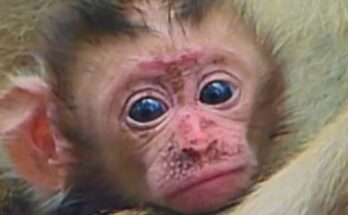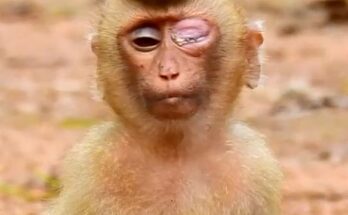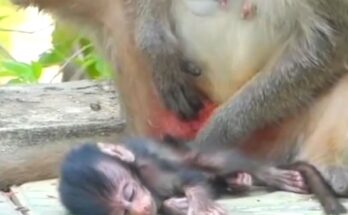In the heart of the jungle, survival is a delicate balance between the instincts of nature and the unpredictability of the environment. One of the most heartbreaking events that occur in the wild is when a mother is unable to care for her young — not for lack of love or effort, but due to biological or environmental limitations. A poignant example of this is when a mother monkey is unable to feed her newborn because of a lack of milk supply. This phenomenon, though not uncommon, highlights the fragile thread that connects life in the animal kingdom.
Milk is the first and most vital form of nourishment for a newborn mammal. In primates, especially, it carries not just nutrients but immune protection, emotional bonding, and warmth. For a mother monkey, producing milk is a natural part of post-birth physiology, triggered by hormonal changes during and after pregnancy. However, in the wild, several factors can interfere with this process, leading to a tragic failure to lactate.
The reasons for a lack of milk supply in wild monkeys can be varied. Malnutrition is one of the most common causes. In many wild environments, especially those affected by human interference, deforestation, or climate change, food sources become scarce. A malnourished mother does not have the necessary fat reserves or nutrients to produce milk. Stress is another critical factor. Constant threats from predators, competition within the troop, or habitat destruction can elevate cortisol levels, which may suppress lactation.
The consequences for the infant are often fatal. Without the mother’s milk, the newborn has little chance of survival. In some cases, the infant may attempt to nurse repeatedly, not understanding why its needs aren’t being met. The mother, deeply bonded to her baby, may show signs of distress, carrying the infant close, grooming it, and protecting it, even as it weakens. The emotional toll on the mother can be immense, and in primates — known for their intelligence and emotional depth — such loss may lead to withdrawal or even depression-like behavior.
From an ecological and scientific standpoint, such cases offer insight into the health of primate populations and their environments. A rise in maternal lactation failures could signal broader issues in the habitat — such as a declining food supply, increasing human encroachment, or environmental contamination. Conservationists and wildlife researchers often monitor maternal behavior and infant survival as key indicators of ecosystem health.
Stories like this also remind us of the complexity and sensitivity of life in the wild. They humanize wildlife, revealing emotional parallels that resonate deeply with our own experiences. The sight of a grieving mother monkey, unable to nourish her baby, elicits a powerful response — one that underscores the urgency of protecting natural habitats and supporting wildlife through conservation efforts.
Ultimately, while nature can be cruel and unforgiving, understanding the struggles faced by animals like the mother monkey adds depth to our relationship with the natural world. It reminds us of the shared vulnerability that binds all living beings and the responsibility we hold in safeguarding the delicate balance that sustains life.


